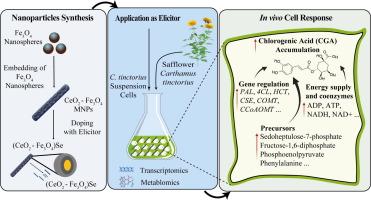硒掺杂CeO2@Fe3O4纳米颗粒在红花细胞悬浮培养中促进次生代谢物生物合成的研究
IF 13.2
1区 工程技术
Q1 ENGINEERING, CHEMICAL
引用次数: 0
摘要
诱导是一种提高次生代谢产物产量的有效策略,而纳米粒子介导的诱导为传统方法提供了一种令人信服的替代方法。马齿苋(C. tinctorius)的悬浮细胞中含有丰富的生物活性绿原酸(CGAs)。然而,掺杂纳米粒子(NPs)刺激细胞内 CGAs 生物合成的机制仍不清楚。因此,本研究首先阐明了硒(Se)掺杂 CeO2@Fe3O4 NPs 的合成和表征,然后探讨了它们对 C. tinctorius 细胞中 CGAs 生物合成的调控作用和机制。通过 TEM、XPS、XRD 和 EDX 分析进行的材料表征证实了掺硒 CeO2@Fe3O4 纳米复合材料的成功合成。Fe3O4、CeO2、Fe3O4@CeO2 和硒掺杂 CeO2@Fe3O4 NP 处理都促进了细胞中 CGA 的生物合成。值得注意的是,用 15 mg L-1 硒掺杂 CeO2@Fe3O4 NPs 处理组的效果最好(37.04 mg g-1,是对照组的 1.92 倍)。最后,代谢组和转录组分析表明,45 种初级代谢物的含量发生了不同程度的变化,83 个 CGA 生物合成相关基因的表达也发生了不同程度的变化。这表明掺硒的 CeO2@Fe3O4 NPs 上调了 CGA 生物合成相关基因的表达,从而增强了 CGAs 在细胞中的积累。该研究首次证明了掺硒 CeO2@Fe3O4 可作为 CGAs 生物合成的纳米诱导剂。本文章由计算机程序翻译,如有差异,请以英文原文为准。

De Novo synthesis of selenium-doped CeO2@Fe3O4 nanoparticles for improving secondary metabolite biosynthesis in Carthamus tinctorius cell suspension culture
Elicitation is a potent strategy to enhance secondary metabolite yield, and nanoparticle-mediated elicitation offers a compelling alternative to traditional methods. Carthamus tinctorius (C. tinctorius) is rich in bioactive chlorogenic acids (CGAs) within its suspension cells. However, the mechanism by which doped nanoparticles (NPs) stimulate the CGAs biosynthesis in the cells remains unclear. Therefore, this study first elucidated the synthesis and characterization of selenium (Se)-doped CeO2@Fe3O4 NPs and then explored their regulatory effect and mechanism for the CGAs biosynthesis in C. tinctorius cells. Material characterization via TEM, XPS, XRD, and EDX analysis confirmed the successful synthesis of selenium-dopped CeO2@Fe3O4 nanocomposite. Fe3O4, CeO2, Fe3O4@CeO2, and selenium-dopped CeO2@Fe3O4 NP treatments all promoted the biosynthesis of CGAs in the cells. Notably, the group treated with 15 mg L-1 selenium-dopped CeO2@Fe3O4 NPs showed best effect (37.04 mg g−1, 1.92 times that of control). Finally, metabolome and transcriptome profiling revealed the differential alterations in the content of 45 primary metabolites and differential expression of 83 CGA biosynthesis-related genes. This suggested that selenium-doped CeO2@Fe3O4 NPs up-regulated the expression of CGA biosynthesis-related genes, and consequently enhanced CGAs accumulation in the cells. This study provides the first evidence that selenium-doped CeO2@Fe3O4 acts as nano-elicitors for the biosynthesis of CGAs.
求助全文
通过发布文献求助,成功后即可免费获取论文全文。
去求助
来源期刊

Chemical Engineering Journal
工程技术-工程:化工
CiteScore
21.70
自引率
9.30%
发文量
6781
审稿时长
2.4 months
期刊介绍:
The Chemical Engineering Journal is an international research journal that invites contributions of original and novel fundamental research. It aims to provide an international platform for presenting original fundamental research, interpretative reviews, and discussions on new developments in chemical engineering. The journal welcomes papers that describe novel theory and its practical application, as well as those that demonstrate the transfer of techniques from other disciplines. It also welcomes reports on carefully conducted experimental work that is soundly interpreted. The main focus of the journal is on original and rigorous research results that have broad significance. The Catalysis section within the Chemical Engineering Journal focuses specifically on Experimental and Theoretical studies in the fields of heterogeneous catalysis, molecular catalysis, and biocatalysis. These studies have industrial impact on various sectors such as chemicals, energy, materials, foods, healthcare, and environmental protection.
 求助内容:
求助内容: 应助结果提醒方式:
应助结果提醒方式:


